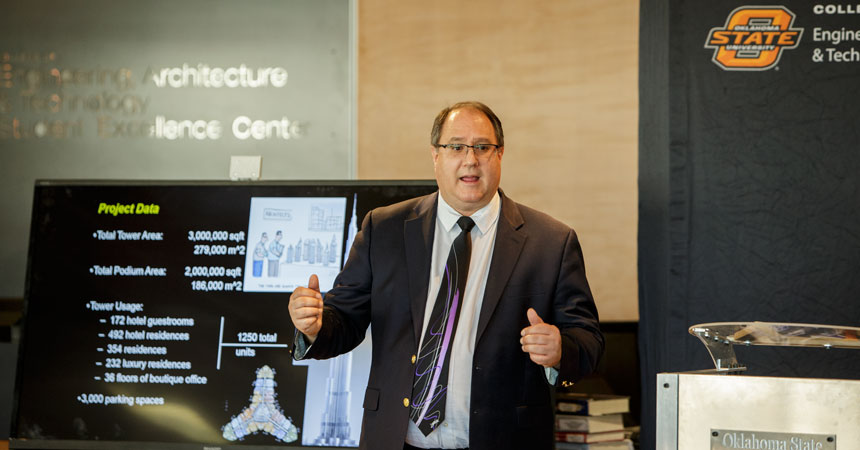Larry Novak presents at OSU CEAT’s Halliburton Global Innovator Series
Tuesday, March 29, 2016

OSU’s College of Engineering, Architecture and Technology (CEAT) hosted Larry Novak as part of its Halliburton Global Innovator speaker series.
Novak currently serves as the director of structural engineering at the Portland Cement Association (PCA). Prior to PCA, he was an associate partner at Skidmore, Owings and Merrill, where he served as the lead structural engineer for the Burj Khalifa, the world’s tallest building, located in Dubai.
At the event, Novak spoke to engineering students, faculty and staff about the importance of structural engineering in modern construction.
“Structural engineering is the part of the natural fabric that ties us all together,” says Novak. “What do we occurs on all scales: from the nano scale of concrete to the size of a beam to an entire building and even something the size of a national roadway system.”
He also shared insight about the work involved with building the world’s tallest structure.
“Construction took about five to six years to complete, and there were many challenges to overcome, such as how to deal with the wind with such a tall structure,” says Novak. “But the architects were able to help with any setbacks and change things that weren’t feasible. The engineers working closely with the architects is what made such a beautiful building possible.”
Novak also had a message for the students in attendance.
“I think it’s important that the students understand that there are tremendous opportunities out there,” says Novak. “Think of the buildings we had 10 years ago versus the buildings we have now, and imagine the years of opportunity and the structures that they could be building when they’re my age.”
About the Burj Khalifa
The Burj Khalifa, formerly known as the Burj Dubai, is the world’s tallest manmade structure. The multi-use skyscraper is over a half mile high (828 meters or 2,717 feet). The three million square foot reinforced concrete tower is utilized for retail, a hotel and residential spaces such as condominiums and offices.
Designers purposely shaped the Burj Khalifa in a ‘Y’ shape to reduce wind forces on the tower, as well as to keep the structure simple and foster constructability. The structural system can be described as a “buttressed” core: each wing, with its own high performance concrete core and perimeter columns, buttresses the others via a six-sided central core or hexagonal hub. The result is a tower that is extremely stiff. Rigorous geometry was applied to the tower to align all of the common central core and column elements.
